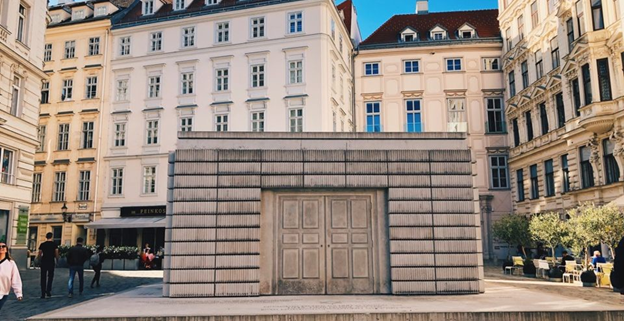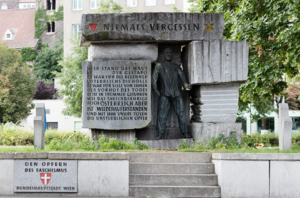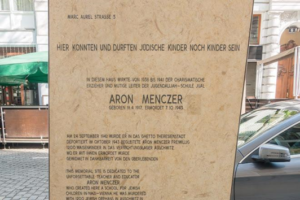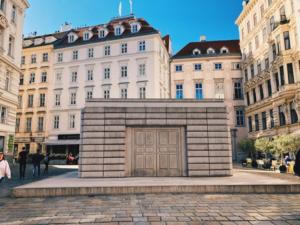Peeling Back the Whitewash: Understanding Austria’s Role in the Past Through its Memorials
By Madison Bollart
Throughout our two weeks of travel in Central Europe, it was rather easy to become captivated by incredible architecture, views, and artistic displays within all of the cities we had the opportunity to visit. Vienna however resonated with me the strongest; not only for what I saw while I was there, but for what I did not see. Austria’s role in the height of Nazi terror appeared to be white washed in its underrepresentation of marginalized victims, particularly Jews, consequently trivializing their suffering. Through the memorials we studied, I came to recognize how they portrayed a limited version of Austria’s history.
This idea was underlined to me while touring the Jewish spaces of Vienna with Julia Windegger of the Jewish Museum Vienna. Mahnmal am Morzinplatz, the “Memorial to the Victims of the Gestapo” initially did not strike me with any interest at all. It is a relatively small stone sculpture with words inscripted in German without translation, and positioned in what seemed like an odd location, right next to a busy main street in Vienna. We then learned that this was a memorial for those who suffered torture, abuse, murder, and deportation under the Nazi rule. The memorial stood at Morzinplatz, the location of the former Gestapo headquarters, which had once been housed in the pre-war “Hotel Metropol.” Julia translated the memorial’s inscription, which I understood to be extremely vague. The text describes the Gestapo headquarters as a place of hell and death for Austrians, who must be remembered as victims.
While the memorial’s construction was initiated by Jewish survivors of the Nazi horrors, it does not acknowledge the Jewish victims at all; it only refers to “victims” fighting for Austria following the country’s annexation by German troops in 1938. Several attempts were made by Austrian Nazis to overtake the government and unite the country with Nazi Germany. Austrian Chancellor Kurt von Schuschnigg maintained hope that Austria could remain a nation independent of the Third Reich, however was pressured by Hitler to appoint Nazis to the Austrian cabinet and resign from his position. Immediately following the coercion, on March 12, 1938 Hitler advanced into Austria and appointed a total Nazi government.
I felt a bit of irony, as I read the words “never forget” etched boldly on this structure. The Jewish survivors who acted to mark their own history, were clearly not being remembered at all. From the very beginning of the Nazi annexation of Austria in 1938, Jews fell as victims to the Third Reich. The Jewish owners of the Hotel Metropol were expropriated by the Gestapo, allowing for the swift adaptation of the building to serve both as its primary headquarters and as a place fit to carry out brutal torture and interrogation. Mahnmal am Morzinplatz bypasses the history of involvement of Austrians in Nazi crimes, and instead emphasizes Austrian victimization. The memorial echoed a great deal of nationalism, ignorance, and whitewashing of the Austrian responsibility. In this way, the countless minority victims are more easily overlooked. It is disheartening and frustrating that this monument, one Jewish survivors hoped would act as a visual piece of memory to the atrocities they endured, is one that ultimately camouflages their suffering.
We were also brought to a memorial honoring Aron Menczer, a Jewish educator, who helped Jewish children emigrate to Palestine. He remained in Vienna after the Nazi annexation of the country and worked with Jewish children, helping them to prepare for life in Palestine. In 1943, at the age of 26, he was deported to Auschwitz with 1200 Jewish orphans and perished with them in the gas chambers. Looking at the Menczer memorial, at first I did find some comfort in the fact that this plaque was simple and straightforward in its intentions to remember a true hero during the Holocaust. However, learning that this memorial was constructed only recently in 2000 under the initiative of the Jewish Theater Nestroyhof Hamakom reiterates a recurring theme of the Jewish struggle to be remembered. The vision was that the memorial be displayed on the building where the school Menczer created for Jewish children was once located. However, the current owners of the building were opposed to the memorial being placed on their property. Because of this, the memorial was placed on the street, inconspicuously positioned on the edge of the sidewalk.
Julia highlighted that Aron Menczer is only known by few, and I feel that this is consistent with the near invisibility of the memorial commemorating him. It is not large nor conspicuous, but can be seen at eye level, and is written in both German and English. It is right across from the hotel we were staying at, and I must have passed it several times without even batting an eye. This supports the idea that the lone existence of a memorial is not sufficient to overcome a marginalized population’s invisibility. Even though this memorial’s message may be simple in its aim to remember, in order to receive it we must take it as our individual responsibility to be aware, to learn, and to understand. I feel that while the constant struggle to be remembered is a difficult one to completely overcome, awareness is a crucial step. How are we supposed to remember someone or something that we have no knowledge of?
Perhaps the most conspicuous and thought provoking memorial I saw in Vienna aimed not only to remember, but to teach a lesson. The Judenplatz Holocaust Memorial or the “Nameless Library” was created in 2000 by the City of Vienna and serves as an important memorial for Austrian victims of the Holocaust. It is situated in the middle of Judenplatz, a square which served as the center of Jewish life in the Middle Ages. The memorial has several distinct symbolic components. However what struck me most was that the doors on the structure do not have door knobs. This can be interpreted as a reminder to Austria; that their actions as perpetrators in the Holocaust cannot be reversed and should not be forgotten nor repeated. In a way, it is holding Austria accountable for their role in these horrors, something Mahnmal am Morzinplatz fails to do. The monument’s form forces us to understand that although that door is closed, the damage done is still incredibly real and lasting. It is important to note that this memorial, alongside the plaque honoring Aron Menczer, was constructed nearly 40 years after the Mahnmal am Morzinplatz. This long delay, and the contested nature of the commemoration process, serves to demonstrate how long it has taken to acknowledge not only the Jewish victims, but the Austrian perpetrators.
While memorials illustrate a great deal about the past, it is important to realize that these structures only act as tools that help us piece together a much wider and complex history. Many memorials throughout Vienna aim to illustrate the atrocities of the Nazi occupied past, however in doing so often they only acknowledge a limited and skewed image about the crimes of the past and of those who suffered. In my travels throughout Central Europe, l have gathered that it is our responsibility as individuals to look at the bigger picture, to use these memorials, and lack thereof, as pieces of a puzzle rather than isolated objects, that can help us better understand and remember the complexity and multiple narratives of the past.
Photo sources:






